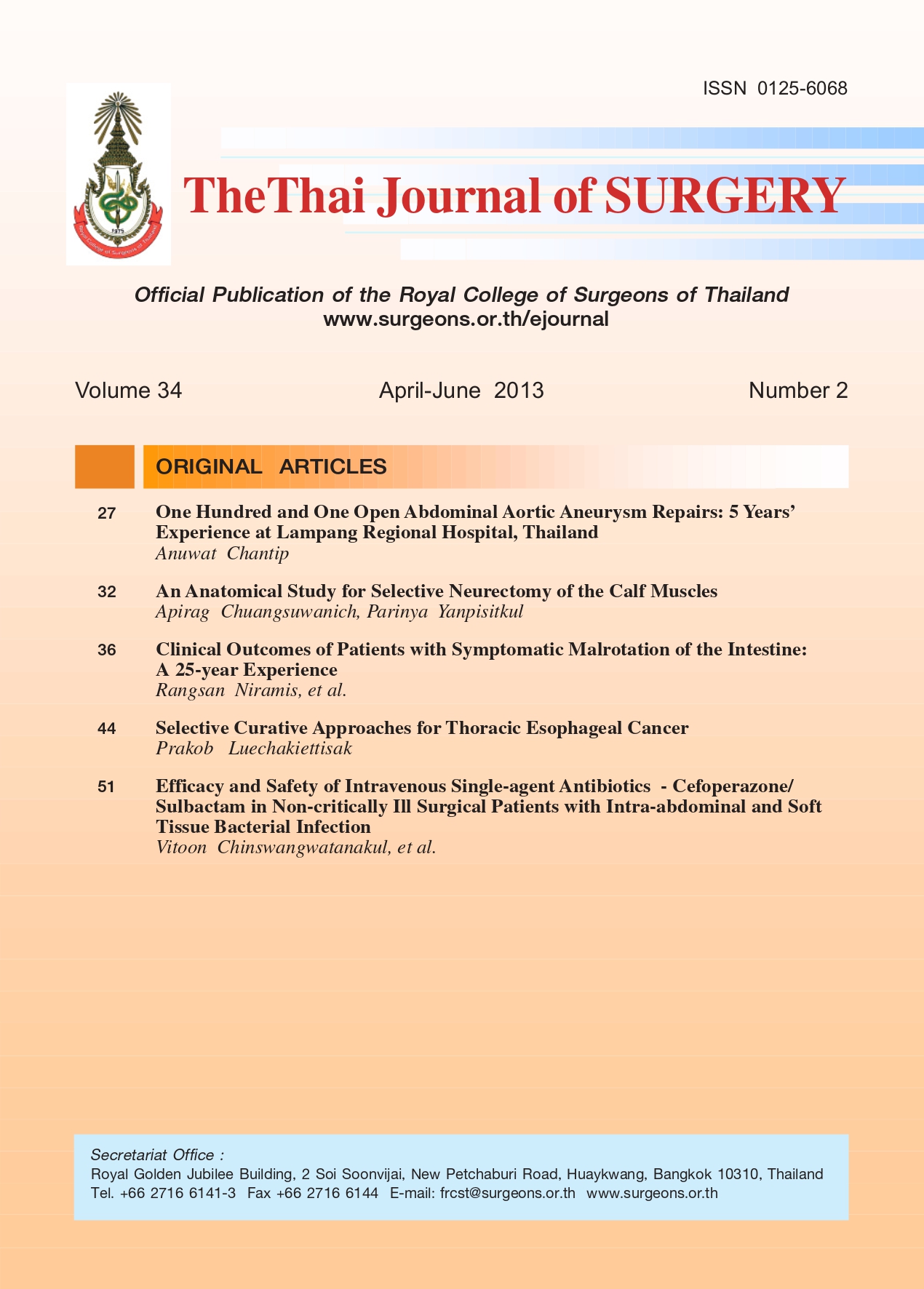Clinical Outcomes of Patients with Symptomatic Malrotation of the Intestine: A 25-year Experience
Keywords:
Malrotation, midgut volvulus, intestinal necrosisAbstract
Objective: The aim of this study was to review results of the treatment of patients with symptomaticmalrotation within a 25-year period at a single tertiary institute in Thailand.
Material and Method: A retrospective study of patients with malrotation of the intestine who were treated at
Queen Sirikit National Institute of Child Health between 1985 and 2009 was undertaken. Special attention was paid
to clinical presentations, radiologic findings and results of treatment. Patients who were found to have malrotation
as an incidental finding at laparotomy for other diseases were excluded from the study.
Results: A total of 153 patients underwent laparotomy for correction of symptomatic malrotation. Most of the
patients developed symptoms, mostly bilious vomiting, within 30 days after birth. Upper gastrointestinal series were
performed in 112 patients and revealed high gut obstruction, abnormal position of the duodenojejunal junction and
corkscrew sign in 97 (87%), 74 (60%), and 38 (34%) patients, respectively. Patients were divided into three groups
based on operative findings. Group A represented 58 patients, of whom 80% were neonates, who had only duodenal
obstruction due to Ladd’s band compression. Only one patient died postoperatively because of congestive heart
failure from congenital heart disease. Group B included 75 patients who had midgut volvulus without intestinal
necrosis. Approximately 70% of group B were neonates, and 3 died from complications of tetralogy of Fallot, severe
pneumonia and gastric perforation, respectively. Group C included the 20 remaining patients who developed midgut
volvulus with intestinal necrosis (involving 20% to 100% of the small intestine). Of these 20 patients, 17 (85%) were
neonates and 8 (40%) died from extensive (> 70%) bowel gangrene. Patients who survived extensive bowel resection
had the total length of viable small bowel over 30 cm. The mortality rate for all 153 patients was 7.8%.
Conclusion: Patients with malrotation developed symptoms within the neonatal period in approximately 80%
of the cases. About two-thirds of intestinal malrotations presented with midgut volvulus and 20% of these had bowel
gangrene. Necrosis over 70% of the small intestine was a significant risk factor for mortality in patients with midgut
volvulus.
References
intestinal tract: presentation of 40 cases of malrotation. Ann
Surg 1954;140:368-80.
2. Stewart DR, Colodny AL, Daggett WC. Malrotation of the
bowel in infants and children: a 15 year review. Surgery
1976;79:716-20.
3. Andrassy RJ, Mahour GH. Malrotation of the gut in infants
and children. Arch Surg 1981;116:158-60.
4. Rescorla FJ, Shedd FJ, Grosfeld JL, Vane DW, West KW.
Anomalies of intestinal rotation in childhood: analysis of 447
cases. Surgery 1990;108:710-6.
5. Brandt ML, Pokorney WJ, Mc Gill CW, Harbery FJ. Late
presentation of midgut malrotation in children. Am J Surg
1985;150:767-71.
6. Spigland N, Brandt ML. Malrotation presenting beyond the
neonatal period. J Pediatr Surg 1990;25:1139-42.
7. Maxson RT, Franklin PA, Wagner CW. Malrotation in the older
child: surgical management, treatment and outcome. Am
Surg 1995;61:135-8.
8. Bryne WJ. Disorders of the intestine and pancreas. In: Tacush
WH, Ballard RA, Avery ME, eds. Diseases of the newborn.
Philadelphia: WB Saunders; 1991: 685-93.
9. Estrada RL. Anomalies of intestinal rotation and fixation.
Springfield, IL: Charles C Thomas; 1958:2-29.
10. Kantor JL. Anomalies of the colon: their roentgen diagnosis
and clinical significance. Resume of 10 years study. Radiology
1934;23:651-62.
11. Filston HC, Kirks DR. Malrotaion - the ubiquitous anomaly. J
Pediatr Surg 1981;16:614-9.
12. Millar AJW, Rode H, Brown RA, Cywes S. The deadly vomit:
malrotation and midgut volvulus. Pediatr Surg Int 1987;2:
172-6.
13. Ford EG, Senac MO, Srikanth MS, Weitzman JJ. Malrotaion of
the intestine in children. Ann Surg 1992; 215: 172-8.
14. Millar AJ, Rode H, Cywes S. Malrotation and volvulus in
infancy and childhood. Semin Pediatr Surg 2003; 12: 229-36.
15. Weinberger E, Winters WD, Liddell RM, Rosenbaum DM,
Krauter D. Ultrasound diagnosis of intestinal malrotion in
infant: importance of the relative position of the superior
mesenteric vein and artery. Am J Roentgenol 1992;159:825-
8.
16. Pacros JP, Sann L, Genin G, Tran-Minh VA, Morin de Finfe CH,
Foray P, et al. Ultrasound diagnosis of midgut volvulus: the
whirpool sign. Pediatr Radiol 1992;22:18-20.
17. Walsh DS, Crombleholme TM. Superior mesenteric venous
thrombosis in malrotation with chronic volvulus. J Pediatr
Surg 2000;35:753-5.
18. Welch GH, Azmy AF, Ziervogel MA. The surgery of malrotaion
and midgut volvulus: a nine year experience in neonates.
Ann R Coll Surg Engl 1983;65:244-7.
19. Powell DM, Othersen HB, Smith CD. Malrotation of the
intestine in children: the effect of age on presentation and
therapy. J Pediatr Surg 1989;24:777-80.
20. Rasmussen L, Andersen OP, Pedersen SA. Intestinal
malrotation and volvulus in infancy. Pediatr Surg Int 1990;5:
27-9.
21. Messineo A, MacMillan JH, Palder SH, Filler RM. Clinical
factors affecting mortality in children with malrotation of the
intestine. J Pediatr Surg 1992;27:1343-5.
22. Prasil P, Flageole H, Shaw KS, Nguyen LT, Youssef S, Laberge
JM. Should malrotation in children be treated differently
according to age? J Pediatr Surg 2000;35:756-8.
23. Murphy FL, Sparnon AL. Long - term complications following
intestinal malrotation and the Ladd’s procedure: a 15 year
review. Pediatr Surg Int 2006;22:326-9.
Downloads
Published
How to Cite
Issue
Section
License
Articles must be contributed solely to The Thai Journal of Surgery and when published become the property of the Royal College of Surgeons of Thailand. The Royal College of Surgeons of Thailand reserves copyright on all published materials and such materials may not be reproduced in any form without the written permission.



